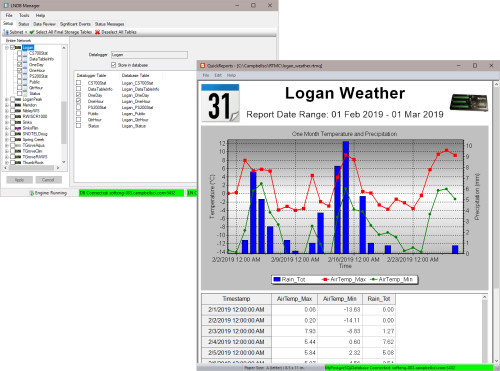
Push data from LoggerNet data cache to relational databases






Visão Geral
LoggerNet DB/U is an upgrade to the latest version of our LoggerNet DB (LNDB) software. You must have an earlier version of LNDB to qualify for the upgrade.
LoggerNet DB (LNDB) is ideally suited for transitioning data from LoggerNet’s data cache to a relational database of your choice. Publishing user-selected LoggerNet collected data to these relational databases enables data administrators to share their data with a large customer base across various platforms and methods. Those platforms could include custom websites (including those developed with RTMC and CSIWEBS), custom data reporting systems, data warehousing, and customer software (web and desktop) applications. This application is for data network administrators that want to push their valuable LoggerNet data into relational databases and have that data published in real time (as often as the data is collected).
The low-cost LNDB software is simple to set up and administer and gives you the flexibility you need for your organization. Most users can have the software installed and LoggerNet data uploading to their relational database in less than 20 minutes' time (assuming the database and LoggerNet are set up and proper credentials are issued to the data manager). After setup, LNDB runs as a service on Windows and continues to reliably push LoggerNet data to the relational database, allowing you to focus your time and energy on other projects.
Leia maisBenefícios e Características
- Upgrade from older version to current version for a discounted price
imagens



Produtos Relacionados
Descrição Técnica
LNDB/U allows users who have an earlier version of LNDB to upgrade to the latest version of LNDB.
Compatibilidade
Please note: The following shows notable compatibility information. It is not a comprehensive list of all compatible products.
Data Loggers
| Product | Compatible | Note |
|---|---|---|
| 21X (retired) | ||
| CR10 (retired) | ||
| CR1000 (retired) | ||
| CR1000X (retired) | ||
| CR10X (retired) | ||
| CR200X (retired) | ||
| CR206X (retired) | ||
| CR211X (retired) | ||
| CR216X (retired) | ||
| CR23X (retired) | ||
| CR295X (retired) | ||
| CR300 (retired) | ||
| CR3000 (retired) | ||
| CR310 | ||
| CR350 | ||
| CR500 (retired) | ||
| CR5000 (retired) | ||
| CR510 (retired) | ||
| CR6 | ||
| CR800 (retired) | ||
| CR850 (retired) | ||
| CR9000 (retired) | ||
| CR9000X (retired) |
Software
| Product | Compatible | Note |
|---|---|---|
| CSIWEBS | ||
| CSIWEBSL | ||
| CSIWEBSL/U | ||
| CSIWEBS Upgrade | ||
| LoggerNet | ||
| LoggerNet Admin | ||
| LoggerNet Admin Upgrade | ||
| LoggerNet Upgrade | ||
| RTMCPRO | ||
| RTMC Pro Upgrade |
Additional Compatibility Information
Supported Databases
LNDB has been tested and shown to work with the following databases:
- Microsoft® SQL Server® (Express, Standard, and Enterprise) 2005–2019
- Microsoft® SQL Server® Compact 3.5 SP2
- MySQL 5.0–8.0 (with an appropriate 32-bit ODBC database driver; for example, MySQL 5.0 or 5.1 with MySQL 3.51.27 or 5.1.6 ODBC database driver, note that earlier versions of 5.x ODBC database drivers have known issues; MySQL 5.6 with MySQL 5.3 ODBC database driver)
- Oracle Database 12c Release 1 (12.1.01) and 18c (18.1.0)
- PostgreSQL 9.4 through 12
Note: LNDB may work with other versions of SQL Server Express, SQL Server Compact, or MySQL.
Computer Requirements
LNDB runs on Windows 11 or 10 and Windows Server 2012 R2*, 2016*, or 2019*.
*Users using Windows Server with security policies other than the default policies will need to work with their IT administrations to resolve any security issues.
Especificações
| Operating System | Windows 11 or 10 and Windows Server 2012 R2, 2016, or 2019. (Users using Windows Server with security policies other than the default policies will need to work with their IT administrations to resolve any security issues.) |
Documentos Relacionados
Lâminas do produto
Perguntas Frequentes Relacionadas
Number of FAQs related to LoggerNet DB Upgrade: 24
Expandir todosRecolher todos
-
Check C:\Campbellsci\LNDB\logs.
-
The LNDB service runs under a local system account by default, which may be why it uses the computer name. Go to Control Panel | Administrative Tools | Services and set it to run under a user name.
-
LNDB currently requires that all data logger table columns have a corresponding database table column. There are currently three options when table definitions change:
- Stop Storing Data (The user can manually alter/archive the database table.)
- Archive Database Table
- Modify Database Table (New columns are added, and old columns are orphaned. If the database column data type is not what is expected, an archive occurs.)
-
No. LNDB works independently of Baler.
-
Yes, as part of the SDK—the CSIDataSource control.
-
If the stations are all accessed by the same instance of LoggerNet, LNDB can collect table data from multiple stations. In the LNDB Manager, highlight the station in the left tree, and select the checkboxes next to the desired table names.
Note: LNDB can only communicate with one instance of LoggerNet.
-
Table names in LNDB are automatically generated and cannot be changed.
-
Not at the same time. Currently, a user would have to manually switch back and forth between the database hosts periodically using the File menu Select Database... option to keep them both updated.
-
LNDB uses two fields as primary keys: the record number and time stamp. If the record number and time stamp are both duplicated, the record is discarded. If only the record number or only the time stamp is duplicated, LNDB should import the record.
-
Yes, but LNDB can only run on a Windows platform. Run LNDB on the same Windows host on LoggerNet, and post the data to MySQL running under Linux. Configure LNDB (running on Windows) to point to the MySQL server running on Linux.
